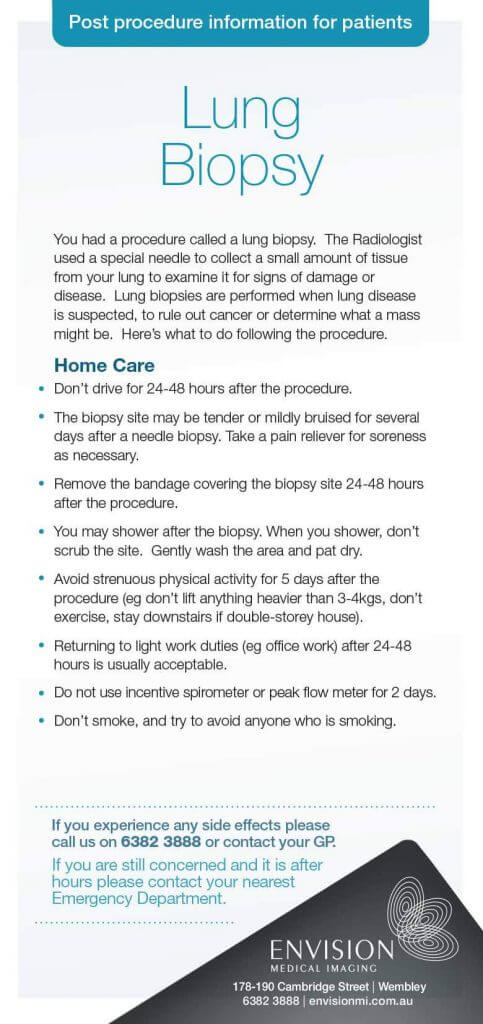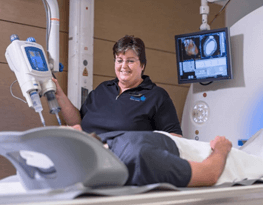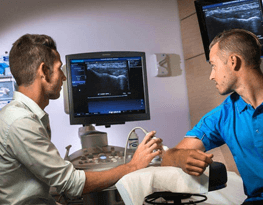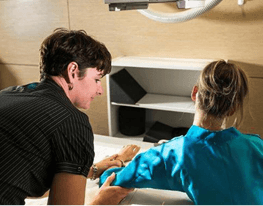What is a Lung Biopsy?

Core Biopsy may sometimes be used instead of FNA. This procedure involves making a small incision in the skin and inserting a larger needle to take the tissue samples. Unlike FNAs, the larger needle size allows the cells to be removed with their relationship to each other intact which may help in diagnosis.Biopsies are done under local anaesthetic.
Both of these procedures are performed under CT guidance by a radiologist.
Lung Biopsy
What happens during a Lung Biopsy?
A. Before your scan
What to bring
- Your request form
- Any relevant previous imaging
- Your Medicare card and any concession cards
Preparation – the day of your procedure
When you arrive for your procedure you will be asked to remove jewellery and change into an examination gown.
B. During your Lung Biopsy
Procedure
The procedure takes about 20 minutes and will be performed in the CT room. The skin above the area of the lesion will be washed with antiseptic and a local anaesthetic may be injected. A biopsy needle is then inserted, guided into position using CT control and a biopsy taken. It may be necessary to make more than one pass of the needle to achieve the proper location and ensure an adequate sample is taken for testing. The needle is removed and compression will be applied to the needle insertion site.
Risks and Side Effects
Complications are rare during this procedure. Find out more about CT Risks and Side Effects.
Additional risks associated with this procedure include:
- Pain or discomfort at the needle insertion site, bruising after the procedure, bleeding at the site, injury to a blood vessel (which may require a blood transfusion), organ puncture, or infection.
- There is a very small possibility that the needle may come into contact with the lung causing a pneumothorax. This is usually small and requires only observation with no medical action. Very rarely, hospital admittance will be required to have a tube inserted to re-inflate the lung.
- The medications used for conscious sedation are associated with the risks of aspiration (inhaling food or liquid into the lungs), or respiratory and/or cardiac depression.
- The sample collected may have non-diagnostic material which may require further investigations.
Any medical procedure can potentially be associated with unpredictable risks.
Do not hesitate to contact our office on 6382 3888 if you have any questions or concerns.
Who will perform my Lung Biopsy?
Your biopsy will be performed by a Radiologist (medical specialist).
Lung Biopsy
What happens after a Lung Biopsy?
How to I get my results?
Your samples will be sent to a pathology laboratory for investigation and the results sent to your doctor. Please make a follow up appointment with your doctor or specialist to discuss your results.
Post-procedural Information
After the biopsy you may be required to remain in the department and observed by our medical staff for a period of time. You will need a driver to take you home. Don’t drive for 24-48 hours after your procedure.
- Some swelling or discomfort is common in the first few days after your injection. You may use an icepack on the injection site for 20 minutes or pain reliever to avoid discomfort.
- Remove the bandage covering the biopsy site 24-48 hours after the procedure.
- You may shower after the procedure. When you shower, don’t scrub the injection site – gently wash the area and pat dry.
- You should refrain from strenuous activity, including walking upstairs and lifting more than 3-4kg for 5 days following your biopsy. You can return to light duties within 24-48 hours.
- Don’t use incentive spirometer or peak flow meter for 2 days. Don’t smoke, and try to avoid anyone who is smoking.
If the infection site becomes red, swollen or tender in the days after your biopsy please consult your doctor or contact us on 6382 3888.

CT Chest, Abdomen and Pelvis
Download
Medical Imaging Practice Perth
Types of Imaging
At Envision, we offer the most sought-after types of imaging for diagnostics and treatments. Our Wembley headquarters is the largest single-site radiology practice in Perth







